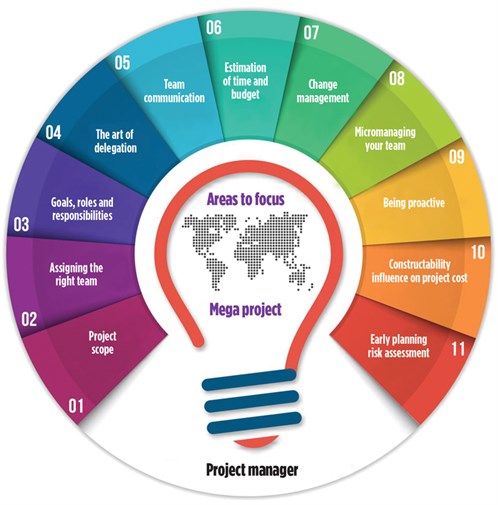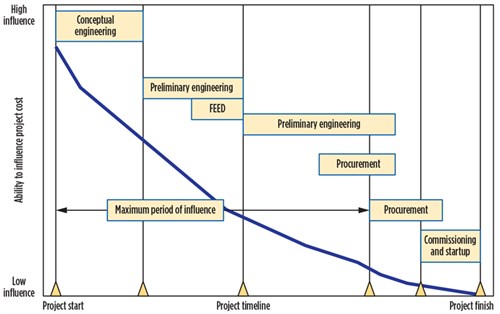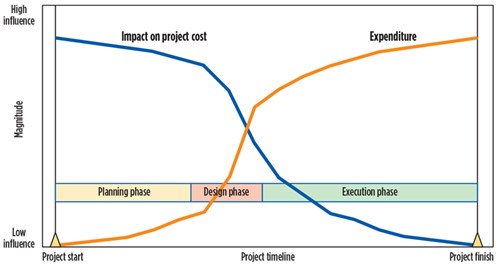A project manager’s challenges in LNG megaprojects
Megaprojects are large-scale, complex ventures that typically cost $1 B or more, take many years to develop and build, involve multiple public and private stakeholders, are transformational and impact millions of people. However, $1 B is not a constraint in defining megaprojects; therefore, megaprojects are characterized by large investment commitment, vast complexity and long-lasting impacts on the economy, the environment, and society.
To be competitive in today’s LNG industry, EPC companies are dealing with many challenges in managing LNG megaprojects. Some of them end up losing money rather than making a profit. Project management is of vital importance to LNG infrastructure projects because of the complex technology and large investments involved, and also because of the remote locations of liquefaction plants. These megaprojects involve the procurement of equipment and services from across the globe, and so they involve a diverse workforce, vendors with different work cultures, and financial institutions that provide a large portion of the project finance. However, even with a strong project management team and a well-defined project management strategy, it is difficult to deliver these projects on time and on budget.
A survey conducted by EY1 identified 365 megaprojects—and, specifically, 50 LNG megaprojects—with an investment of $1 B or more. The average project size was $10 B, and the total investment values in the 50 LNG megaprojects were estimated at $539 B. Of this $539 B, North America was host to $482 B of LNG megaprojects. The shocking outcome of this survey was that 67% of these LNG megaprojects faced cost overruns, while 68% experienced schedule delays and 70% faced project budget overruns. The reasons for these delays and overruns can be divided into internal and external factors. This article focuses on the internal factors, particularly those related to the role of the project manager.
As a backdrop to these challenges, traditional project management methodologies are often no longer considered effective to meet the continuously changing needs of LNG megaprojects. To succeed, the project management team must be adaptive and agile. In the challenging environment caused by COVID-19 and decreased demand for LNG, it is even more important for an LNG megaproject to be successful, on time and on budget. It is important to minimize the risk of these projects not producing expected benefits—i.e., failing to deliver on time and budget.
Focus areas for a project manager. Based on discussions with a number of senior and peer engineers, the author has compiled a list of 11 prominent areas (FIG. 1) where the probability of problems emerging on a megaproject is much higher. A project manager must focus on these areas to be successful in managing a megaproject. Finding the right project manager to lead an LNG megaproject is so difficult that the author has witnessed an engineering company in Houston, Texas change three project managers during the detailed engineering phase of an LNG megaproject in response to performance issues.
 |
| FIG. 1. Essential areas of focus for project managers on LNG megaprojects. |
Area 1: Project scope. An unclear scope is a major problem in megaprojects where companies win a lump-sum contract but the scope is not well-defined, is incomplete, is not properly communicated or is not agreed upon. As per the aforementioned EY survey, 58% of megaprojects in North America face cost overruns; one of the major reasons is poorly defined scope. The scope must be properly defined, communicated and agreed upon by all members of the team for a project to be successful. As an example, in one of the megaprojects executed by the author in his role as a project manager, the scope was so poorly defined that the project required more than 50 change orders.
Area 2: Assigning the right team to manage the project. A team that lacks the necessary experience and skills can be a leading reason for the failure of a project. As per the EY survey, 55% of megaprojects in North America face schedule delays. A major internal reason for these delays is the assignment of an inadequate team to execute and manage the project. In today’s world, companies hire and fire based on project needs. A project manager should ensure that people joining the project have the right experience, knowledge and attitude. It is always best to hire the most qualified personnel and ensure that they are not working in silos.
Area 3: Goals, roles and responsibilities. The team should have a clear idea of the project goals, roles and responsibilities. If goals are not clearly defined, it can be difficult to interpret when the goals have been achieved and when the project can be considered successful. Roles and responsibilities should be clearly defined so that each team member knows exactly what is expected of them at the start of each project, and so that no responsibilities or tasks fall through the cracks.
Area 4: The art of delegation. Project managers tend to do a lot of things by themselves. Sometimes, they become so involved with the project that they forget the art of delegation, which can adversely impact project health. A project manager should listen to team members’ suggestions and learn how to delegate tasks to show that they trust the abilities of their team. An effective project manager succeeds in getting the job done alongside their team, irrespective of the team members’ experience, discipline, age, cultural background, etc.
Area 5: Managing the global workforce. Megaprojects are executed in different offices around the globe simultaneously. Most EPC companies have a high-value engineering center (HVEC) in India, China, the Philippines or some other country where the labor rate is much lower than in the home country, such as the U.S., Canada or Europe. The idea of using HVEC labor serves two purposes: (1) it brings down the overall labor cost, and (2) project work is being done around the clock because of different time zones. As a standard practice, 25% of engineering work during the front-end engineering design (FEED) stage and 40% of engineering work during the detailed design stage are shared with HVEC centers.
During the author’s role as a project manager, I simultaneously managed three workforces in the Houston, London and New Delhi offices. Our team completed the project within the assigned budget and well before the scheduled deadline. In this role, an effective project manager must understand the teams and adapt to their work cultures. Flexibility is required, as is the utilization of new tools and methods to provide a team with a sense of ownership.
Also, engineering work must be coordinated in such a way that the HVEC team is not completely dependent on its counterparts in the U.S. or UK office to answer their queries many hours or days later; otherwise, the purpose of working around the clock will be lost.
Area 6: Team communication. One of the basic qualities of a successful project manager is successful team communication; however, this is an often-ignored quality. Sometimes, project managers with many years of experience fail to efficiently communicate with the team and assume that the team is already on the same page with them. When any misunderstanding occurs, everyone on the team points fingers and blames one another. However, if a project manager ensures that the team members are communicating with one another efficiently, then the project will head toward success. Regular “toolbox meetings” (short periodical consultations) with the team are highly recommended. Team communication is more complicated when the project is being executed in different offices around the globe. These modern-day problems need simple, modern-day solutions like Microsoft Teams meetings, where team members from different countries can join the team toolbox meetings from the comfort of their homes and be part of a single team rather than working in silos.
Area 7: Change management. Changes in scope are a common cause of failure in megaprojects, but they occur frequently and must be successfully managed. It is important to keep track of all changes and their impacts on the project schedule and budget. As per the EY survey, the average completion costs of megaprojects are 59% higher than the initial estimate. One of the internal reasons for these cost increases is failure to follow change management procedures. It is particularly important not to start work until the change order is approved by the client. Although a change management procedure is in place in almost every company, some project managers still move forward with incorporating changes before the client approves them. This step creates further problems in the project. A project manager should be held accountable for adhering to change management guidelines.
Area 8: Micromanaging the team. Some project managers act like police, checking and enforcing the team for projects and updates. They micromanage the project because they lack confidence in their team’s abilities. This is connected to the art of delegation. When a project manager delegates a task to their subordinates, the team should be given enough time and confidence to do the job. Instead of micromanaging the team, a project manager should lay out the responsibilities and expectations during regularly scheduled meetings so that the team can update and show the progress of its work. An effective project manager should always share the positives and negatives from the progress report with the team members so that they know the exact numbers and feel that they are driving those numbers.
Conversely, in the micromanaging atmosphere, leads will come up with problems but no solutions because they lack a sense of ownership of the project. In an atmosphere where the team has a sense of ownership, leads come up with problems and devise multiple solutions. Self-accountability of the team improves drastically with a sense of ownership.
Area 9: Being proactive. By the time a project manager realizes that a megaproject is in trouble, many labor hours have already been spent. It is almost impossible to recover from this stage to make the megaproject successful. As an example, on one LNG megaproject, an engineering company directed its employees to work 70 hours per week to catch up with the schedule, which was a difficult task. After five months of 70 hours per week of work, the project manager realized that the team would overrun the budget even before the engineering was finished. If the project manager had taken a proactive approach in the beginning stage of the project and followed the schedule correctly, the schedule delay and the excessive working hours could have been avoided.
To avoid schedule delays, a work schedule must be created that shows who is responsible for what, and when these tasks should be finished. At every team meeting, the team should be encouraged to achieve these milestones so that it understands how far it is to the finish line. A project manager should hold the leads accountable for their tasks from the start of the project.
Area 10: Constructability influence on final project cost. The maximum impacts on the final project cost and schedule occur in the planning stage (FIG. 2). After procurement and construction have begun, it is usually too late to make major impacts to reduce the cost and time expended. A project manager must involve construction and commissioning personnel during the early engineering phase so that lessons learned from construction can be implemented. This will result in fewer requests for information, and the construction and commissioning teams can better plan their work.
 |
| FIG. 2. Constructability impact on final project cost. |
Area 11: Early planning risk assessment and decision-making. To control cost and schedule, early planning risk assessment and mitigation are necessary and should be well established (FIG. 3). A dedicated risk manager or a project manager should perform these risk-related tasks in the early phase of the megaproject. Early-stage risk assessment aids learning and enables decisions to be made under conditions of less uncertainty. As the project progresses, the impacts of risk mitigation and decision-making decrease.
 |
| FIG. 3. Risk management and decision-making influence on project cost. |
Takeaway. The difference between an effective project manager and an average project manager is that the effective project manager believes in learning continuously on every project. A project manager implements lessons learned from previous projects and treats each team as a fresh group. The opportunity to learn is present in every project and from different individuals on the team. An effective project manager must be a leader, rather than just a manager. A leader is proactive, a good listener and celebrates project victories with the team to boost employee morale and to reach the common goal of executing the project under budget and on time. GP
LITERATURE CITED
- EY, “Spotlight on oil and gas megaprojects,” 2014, online: https://www.ey.com/Publication/vwLUAssets/EY-spotlight-on-oil-and-gas-megaprojects/%24FILE/EY-spotlight-on-oil-and-gas-megaprojects.pdf
 |
DEEPAK BAWA is a Project Management Professional (PMP) with experience in LNG, hydrogen, ammonia, methanol and refinery projects, among others. He is Director of Project Development for New Fortress Energy. Mr. Bawa is a Six Sigma Green Belt Certified PMP with significant experience spanning more than 17 yr. He has experience leading teams of 40–100 people for EPC projects ranging from $2 MM–$4 B. In the past, he has worked with companies including Kiewit, KBR, IHI, UOP, TechnipFMC and ISGEC. Mr. Bawa holds a BS degree in mechanical engineering from the Sant Longowal Institute of Engineering and Technology in Longowal, Punjab, India.




Comments